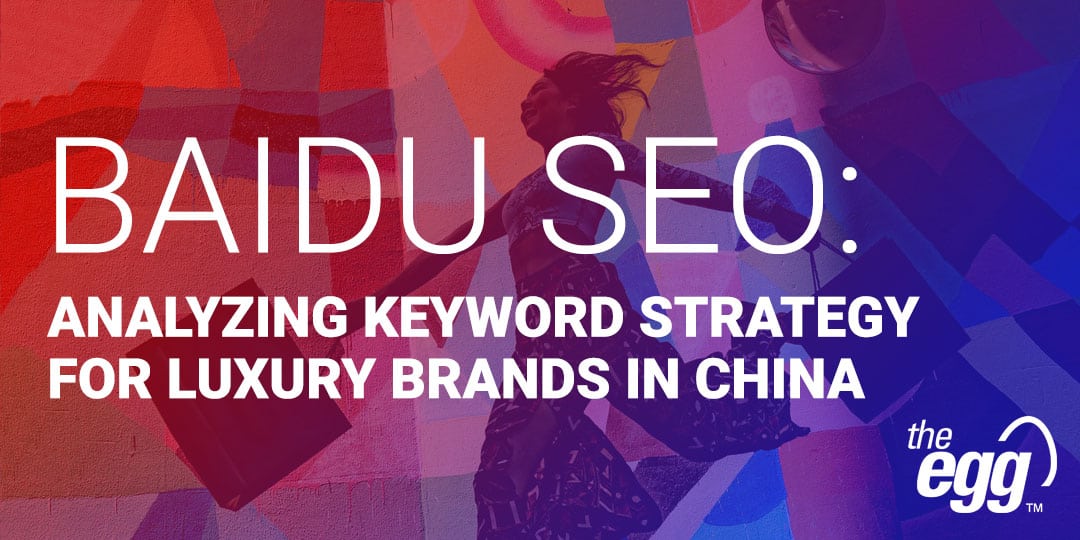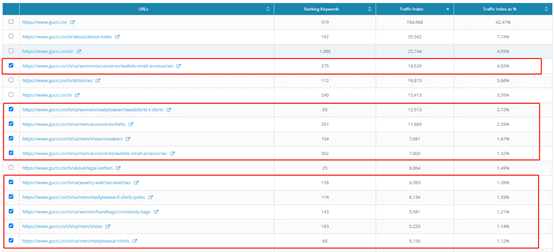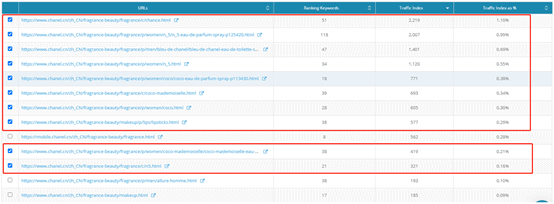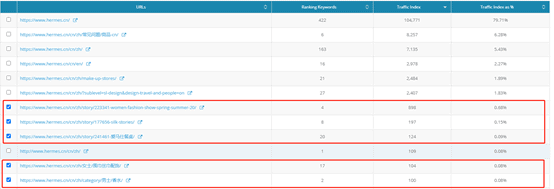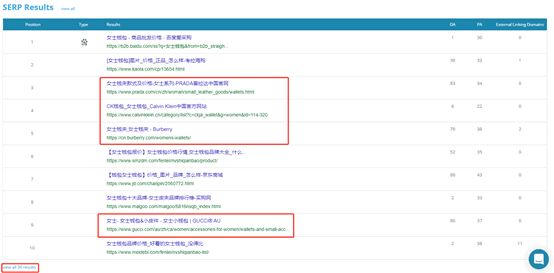China SEO: Who Dominates Traffic in the Luxury Industry?
The meteoric rise of e-commerce in Mainland China has pitched brands against each other in a battle for visibility and clicks—for most, keyword analysis has been the weapon of choice for beating competitors.
Among the most competitive arenas for SERP supremacy is the luxury industry, where online engagement—everything from website clicks, brand name searches, and social interactions—has grown year-on-year. How then should luxury brands seize this digital opportunity?
Let’s examine traffic performance based on the keyword strategies of three of the luxury industry’s biggest players: Gucci, Chanel, and Hermes. For our research, we used Dragon Metrics—China’s top SEO research tool that automates reports across the world’s major search engines, including Baidu.
Baidu SEO Keyword Performance: Gucci, Chanel, Hermes
Using Dragon Metrics, let’s first examine the keyword performance of the official Chinese websites of the three luxury brands.
Keyword performance: Gucci official CN website
Keyword performance: Chanel official CN website
Keyword performance: Hermes official CN website
Based on its high volume of incoming traffic and ranked keywords at 9,300, Gucci’s official CN website is the best overall performer compared to its two competitors. Its estimated organic traffic for its keyword set—with a traffic index of 459,500—is also two to three times greater than those of the other two brands.
So, what makes Gucci’s keyword strategy such a standout performer?
Web Traffic Performance: Branded vs. Non-Branded Keywords
Do Branded Keywords Reveal the Highest Driver of Traffic?
The incoming traffic for all three brands is predominantly driven by branded keywords—both Chinese and English variations.
| Brand | Keyword | Monthly Search Volume | Est. Organic Traffic |
| CHANEL | 香奈儿 | 490,410 | 52,538 |
| CHANEL | 190,140 | 20,771 | |
| GUCCI | 古驰 | 191,460 | 20,939 |
| GUCCI | 535,230 | 58,687 | |
| HERMES | 爱马仕 | 368,670 | 40,401 |
| HERMES | 72,840 | 7,797 |
Keyword performance for Chanel, Gucci, and Hermes’ branded keywords
The table above showcases the monthly search volumes (MSVs) and estimated monthly organic traffic for each branded keyword. By comparing the differences in their incoming MSVs, not much separates the three brands.
To this end, the traffic for branded keywords cannot explain Gucci’s superiority over the other two brands. Then, what about non-branded keywords?
How do non-branded keywords drive traffic?
Apart from their homepages, let’s observe how much traffic is brought in by each brand’s other webpages.
Gucci’s Traffic Performance (By Webpage)
Dragon Metrics: Ranking keywords and traffic indices for Gucci’s webpages
Excluding Gucci’s homepage and ‘about us’ pages, which capture traffic primarily using branded terms, its product listing pages (outlined in red) contain many ranked keywords that are non-branded—like “lady wallet”, “lady T-shirts”, “men’s belts”. Based on their traffic indices, all the listing pages bring in thousands—even tens of thousands—of organic traffic each month.
Chanel’s Traffic Performance (By Webpage)
Dragon Metrics: Ranking keywords and traffic indices for Chanel’s webpages
Many of Chanel’s landing pages have product offerings and drive traffic through product terms related directly to the brand–like “No. 5 perfume” and “Coco perfume.”
Although relatively easy to rank for, such branded-product keywords do not garner as much search volume as the more general non-branded product keywords: Gucci captures searchers who may not even be looking specifically for Gucci products but find them anyway, while Chanel misses out on those opportunities. In Chanel’s case, its product pages only derive between 150 to 2,200 MSV—that means it may take up to 5 or 6 such pages to equal the traffic brought in by Gucci’s listing pages.
Hermes’ Traffic Performance (By Webpage)
Dragon Metrics: Ranking keywords and traffic indices for Hermes’ webpages
Apart from its homepage, Hermes drives much of its traffic from its blogs (outlined in red)—like the one about the Spring and Summer Women’s Show and Vientiane Square Scarfs.
These blogs generally feature long-tail keywords—although easier to rank for due to lower competition, their search volume is less than that produced by short-tail keywords. Altogether, Hermes’ blogs garnered only just over 1,000 average MSV.
This quick analysis of the sites’ SEO performance on Dragon Metrics revealed the strengths and weaknesses of each brands’ keyword strategy as well as which one was the strongest traffic competitor: Gucci.
How To Conduct Keyword Research
One tried-and-tested method to counter sub-par keyword performance is to target more related keywords and rank for them on the SERP. For this purpose, Dragon Metrics’ keyword research tool is particularly useful.
Take the popular term “lady’s wallet” for example. Upon searching for the term on Dragon Metrics, a keyword overview with useful information will appear.
Dragon Metrics: Keyword overview for “lady’s wallet”
The overview above displays the search volume for “lady’s wallet”—broken down by desktop and mobile searches. Dragon Metrics can also prioritize the keywords for which you have the best likelihood of gaining traffic. The platform uses these metrics in its assessment:
- Organic difficulty
Organic difficulty measures the backlink strength of sites ranked on page 1 of the SERP and reveals how many backlinks it takes to rank in the top 10 results.
- Organic CTR
Organic CTR measures how much of page 1 results are made up of ads, rich results, and various SERP features. This illuminates the percentage of clicks that go to organic results and helps you de-prioritize keywords that generate results below the fold.
- Priority
Priority is an aggregate score—made up of search volume, keyword difficulty, and organic CTR—that reveals a keyword’s organic traffic potential. Lower keyword difficulty and higher search volume and organic CTR make for a higher priority score.
Dragon Metrics: Keyword ideas for “lady’s wallet”
Using the topics and questions related to “lady’s wallet”, or keywords containing the phrase itself, we can pinpoint the pages containing that relevant keyword—whether they are product or information pages.
At the same time, if you notice that your website does not feature those high-quality keywords, you should create a landing page to cover them, so as not to miss out on high-value traffic.
Lastly, in its keyword research tool, Dragon Metrics lists the sites that currently occupy the top 10 positions on the SERP for any keyword, alongside other SEO ranking metrics like:
- Page authority (PA)—out of 100
- Domain authority (DA)—out of 100
- Backlink volume for each domain
Dragon Metrics: Top 10 SERP results for “lady’s wallet”
For “lady’s wallet”, you’ll be able to see all 30 results of the keywords. In addition to Gucci, Prada, CK, and Burberry all ranked in the top 10 results, demonstrating how ferociously luxury brands are competing to rank for these generic words.
***
“Only by knowing yourself—and the enemy—can you win the battle” is a Chinese proverb that also speaks volumes in the SEO world. Monitoring your competitors’ keyword ranking is significant in evaluating how your website performs against theirs on search engines.
Using Dragon Metrics’ data and automated reporting, you can evaluate the SEO health of your site and pinpoint sections that need further optimization to beat your competitors.
Pro-Tip: As The Egg’s sister company, Dragon Metrics is a proprietary tool developed as the first truly global SEO platform that provides rank tracking, onsite optimization reports, link management, keyword research tools, and more for search engines around the world. Here, we look specifically at Dragon Metrics’ prowess on Baidu, China’s #1 search engine with 222+ million active users, but Dragon Metrics works for all of the world’s major search engines.


